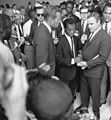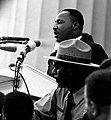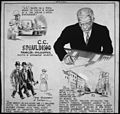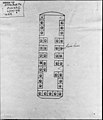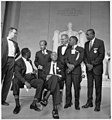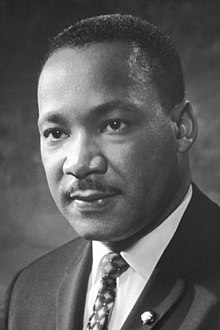Portal:Civil rights movement
The civil rights movement portal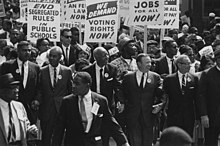 The civil rights movement was a social movement and campaign in the United States from 1954 to 1968 that aimed to abolish legalized racial segregation, discrimination, and disenfranchisement in the country, which was most commonly employed against African Americans. The movement had origins in the Reconstruction era during the late 19th century, and had modern roots in the 1940s. After years of direct actions and grassroots protests, the movement made its largest legislative and judicial gains during the 1960s. The movement's major nonviolent resistance and civil disobedience campaigns eventually secured new protections in federal law for the civil rights of all Americans. After the American Civil War and subsequent abolition of slavery in the southern states in 1865, the three Reconstruction Amendments to the United States Constitution had granted emancipation and constitutional rights of citizenship to all African Americans, the majority of whom had recently been enslaved. For a short period of time, African-American men voted and held political office, but as time went on Blacks in the South were increasingly deprived of civil rights, often under racist Jim Crow laws, and were subjected to discrimination and sustained violence by White supremacists. African Americans who moved to the North to enhance their prospects in the Great Migration also faced barriers in employment and housing. Over the following century, various efforts were made by African Americans to secure their legal and civil rights, such as the civil rights movements of 1865–1896 and of 1896–1954. The movement was characterized by nonviolent mass protests and civil disobedience following highly publicized events such as the lynching of Emmett Till in 1955. These included economic boycotts such as the Montgomery bus boycott, "sit-ins" in Greensboro and Nashville, a series of protests during the Birmingham campaign, and a march from Selma to Montgomery. The movement was led by Martin Luther King Jr., James Bevel, and others, and press coverage of police violence using fire hoses and dogs against students attempting to walk to City Hall to talk with the mayor during the Birmingham campaign increased its public support. Discrimination was often supported by courts, including by the Supreme Court in its 1896 decision Plessy v. Ferguson, which upheld the doctrine of separate but equal. At the culmination of a legal strategy pursued by African Americans, in 1954 the Supreme Court struck down the underpinnings of laws that allowed racial discrimination as unconstitutional in Brown v. Board of Education. The Warren Court made further pro-civil rights rulings in cases such as Browder v. Gayle (1956) and Loving v. Virginia (1967), banning segregation in public schools and public transport, and striking down all state laws against interracial marriage. Following the March on Washington in 1963, moderates in the movement worked with the United States Congress to achieve the passage of several significant pieces of federal legislation that authorized oversight and enforcement of civil rights laws. The Civil Rights Act of 1964 banned all discrimination based on race, color, religion, sex, and national origin, including in schools, employment, and public accommodations. The Voting Rights Act of 1965 restored and protected voting rights for minorities and authorized oversight of registration and elections in areas with historic under-representation of minority voters. The Fair Housing Act of 1968 forbade property owners from discriminating in the rental or sale of housing. (Full article...) Selected article -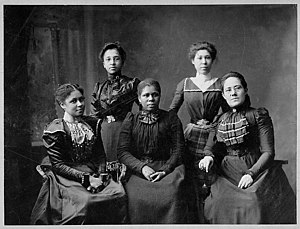 The club movement is an American women's social movement that started in the mid-19th century and spread throughout the United States. It established the idea that women had a moral duty and responsibility to transform public policy. While women's organizations had existed earlier, it was not until the Progressive era (1896–1917) that they came to be considered a movement. The first wave of the club movement during the progressive era was started by white, middle-class, Protestant women, and a second phase was led by African-American women. These clubs, most of which had started out as social literary gatherings, eventually became a source of reform for various issues in the U.S. Both African-American and white women's clubs were involved with issues surrounding education, temperance, child labor, juvenile justice, legal reform, environmental protection, library creation and more. Women's clubs helped start many initiatives such as kindergartens and juvenile court systems. Later, women's clubs tackled issues like women's suffrage, lynching and family planning. The clubs allowed women, who had little political standing at the time, to gain greater influence in their communities. As women gained more rights, the need for clubs to exercise political and social influence became less important. Over time, participation in women's clubs has waned in the United States. However, many clubs still continue to operate and influence their communities. (Full article...) General imagesThe following are images from various civil rights movement-related articles on Wikipedia.
Related portalsWikiProjectsSelected biography -Martin Luther King Jr. (born Michael King Jr.; January 15, 1929 – April 4, 1968) was an American Baptist minister, activist, and political philosopher who was one of the most prominent leaders in the civil rights movement from 1955 until his assassination in 1968. King advanced civil rights for people of color in the United States through the use of nonviolent resistance and nonviolent civil disobedience against Jim Crow laws and other forms of legalized discrimination. A black church leader, King participated in and led marches for the right to vote, desegregation, labor rights, and other civil rights. He oversaw the 1955 Montgomery bus boycott and later became the first president of the Southern Christian Leadership Conference (SCLC). As president of the SCLC, he led the unsuccessful Albany Movement in Albany, Georgia, and helped organize some of the nonviolent 1963 protests in Birmingham, Alabama. King was one of the leaders of the 1963 March on Washington, where he delivered his "I Have a Dream" speech on the steps of the Lincoln Memorial, and helped organize two of the three Selma to Montgomery marches during the 1965 Selma voting rights movement. The civil rights movement achieved pivotal legislative gains in the Civil Rights Act of 1964, the Voting Rights Act of 1965, and the Fair Housing Act of 1968. There were several dramatic standoffs with segregationist authorities, who often responded violently. (Full article...) Selected image -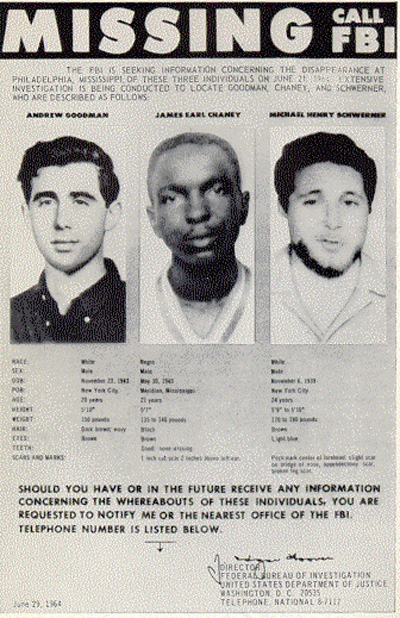 Missing persons poster created by the FBI in 1964, signed by the Director J. Edgar Hoover. Shows the photographs of Andrew Goodman, James Chaney, and Michael Schwerner. All three were found to have been later murdered by local White Knights of the Ku Klux Klan, and the Neshoba County Sheriff's Office as well as the Philadelphia, Mississippi Police Department were involved in the incident. Did you know?
TopicsSubcategoriesThings to doAssociated WikimediaThe following Wikimedia Foundation sister projects provide more on this subject:
Discover Wikipedia using portals
|





